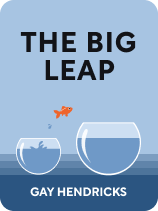

This article is an excerpt from the Shortform book guide to "The Big Leap" by Gay Hendricks. Shortform has the world's best summaries and analyses of books you should be reading.
Like this article? Sign up for a free trial here .
Do you feel fulfilled in your life? Do you find that you tend to revert to your old patterns once you finally get in the “flow”?
Living a fulfilled life is different from living the life most people are accustomed to. Therefore, it will take a whole overhaul of your life and a serious amount of diligent maintenance to avoid falling back into your old patterns of thought and behavior.
Here are some practical changes you can make in your life to make a state of fulfillment your default state.
Set Healthy Boundaries
Living a fulfilled life requires that you prioritize spending time on activities that enhance that state, and avoid activities that don’t. But one of the most common boundary problems people tend to struggle with is saying “no.” When you take stock of what you tend to spend time on, you may notice you invest a lot of energy into doing things you really don’t want to do, because you feel obligated to say “yes” to others. Hendricks suggests you start saying “no” to anything you can that doesn’t align with your state of fulfillment.
Each time you’re asked to do something, don’t respond immediately. Take some time first to think about whether it aligns with life in your state of fulfillment. Of course, doing things in the service of others often feels fulfilling, so in those cases, say “yes.” However, in some cases, you may conclude that saying “yes” to something would be counterproductive to your fulfillment. For instance, if you’re asked to take on an extra project at work, but that would mean sacrificing spending time with your family, you may decide that’s not worth the sacrifice, even if it would mean extra money. In this case, spending time with your loved ones will enhance your state of fulfillment more than money will. So, you must say “no.” Hendricks calls this an “Enlightened No” because you’re explicitly saying no for a higher purpose—the purpose of living in your state of fulfillment.
(Shortform note: The internet abounds with self-care advice extolling the virtue of saying “no.” However, there may also be good reason to critique this practice, as well as other practices encouraged under the guise of self-care. We need to be careful that we’re saying “no” for the right reasons, and not just to avoid responsibility or obligations to others.)
Redefine Your Relationship to Time
Another common defeating behavior people tend to engage in is not using their time effectively. This creates a constant source of life stress for many of us. Hendricks suggests that this really stems from a faulty way of thinking about time, and he offers a different perspective to shift your thinking in this area. When you transform your thinking about time, you remove the stress created by the idea that there’s “not enough” or “too much” time. This allows you to feel more peace and abundance in your life and to devote more time to those things that enhance your state of fulfillment.
The shift in thinking Hendricks suggests essentially involves changing your concept of time as something outside of you that constrains you, to something that comes from within you and is abundant. He explains the difference in terms of Newton’s and Einstein’s theories, where the Newtonian model is the way we typically think of time, as objective and finite, as opposed to Einstein’s concept of time as relative and subjective.
(Shortform note: Reviewers of the book have raised questions about whether Hendricks’s descriptions here accurately represent the theories of Newton and Einstein. But if we take them as loose interpretations, we can use these concepts as a basis for thinking about how to use time more wisely. Some fairly simple shifts you can make are: Try focusing your attention fully on the present moment, spend less time thinking about doing things and more time doing them, and don’t get distracted by the “small stuff” that wastes time.)
A concept of time based on Einstein’s model would mean understanding that time is relative to our experience of it. Depending on what we’re doing, it can feel like it goes faster or slower—we’ve all had this experience. Time seems to drag when you’re waiting for medical test results, but flies by when you’re on vacation. Hendricks argues that this is due to how your attention is focused. When you fully focus your attention in the present moment, you can use the time more deliberately.
You can use this relativity to your advantage by realizing that you control your experience of time; thus, simply understanding time from this new mindset will be a positive step toward eliminating the constant feeling of rushing from our lives.
As a practical step, Hendricks suggests you can begin by changing how you speak about time. Notice where you complain about time, for example how often you say you “don’t have time” to do something. Usually when we say this we really mean we don’t want to do it. It’s more about our priorities. If something is important you’ll “make time” for it. According to Hendricks, this means you can always make time. So, as a first step in changing your perception of time, Hendricks urges you to eliminate any complaining about time, or reference to time constraints, from your language.
Mantra Meditation
Another practical tool Hendricks offers for maintaining a state of fulfillment is a mantra meditation. A mantra is a word or phrase used to help train the mind to be in the present and redirect it from negative thought patterns. (Shortform note: The Chopra Institute, founded by world-renowned guru Deepak Chopra, explains that a mantra can be understood as a seed you plant in your mind, to grow an intention into a realization.)
Hendricks has formulated a mantra specifically designed for combatting the false beliefs and limiting behaviors discussed in this book. It serves to open your mind to accepting all of the abundance of life in your state of fulfillment. He calls this the Universal Success Mantra, or USM.
His mantra is: “I expand in abundance, success, and love every day, as I inspire those around me to do the same.”
Hendricks gives instructions for repeating the mantra in sequence with your breath in meditation daily. Notice any resistance your mind has to the mantra. It’s natural—just notice it and go back to the mantra. It will take practice to retrain your mind; you’re deprogramming from a lifetime of embedded false beliefs. In addition to setting aside time to focus on your mantra in meditation, occasionally just repeat it as you go about your day any time you think of it. Hendricks also suggests that you may want to write the mantra down on pieces of paper and put them where you’ll see them throughout the day, for example in your house, car, or office, in order to prompt yourself to repeat it regularly.
Recommit Regularly
As a final word of advice for ensuring that you remain in your state of fulfillment, Hendricks emphasizes continuous re-commitment. He warns that you must be diligent about watching for old patterns to emerge, or the false beliefs to creep up. Use those as a reminder to commit again to living in your state of fulfillment. Any time you start to feel negativity, dissatisfaction, or unhappiness, make a conscious re-commitment and repeat your mantra.

———End of Preview———
Like what you just read? Read the rest of the world's best book summary and analysis of Gay Hendricks's "The Big Leap" at Shortform .
Here's what you'll find in our full The Big Leap summary :
- How to overcome the psychological barriers to success and fulfillment
- Why most people have a self-imposed limit to happiness
- How to identify your own false beliefs and stop self-sabotaging






